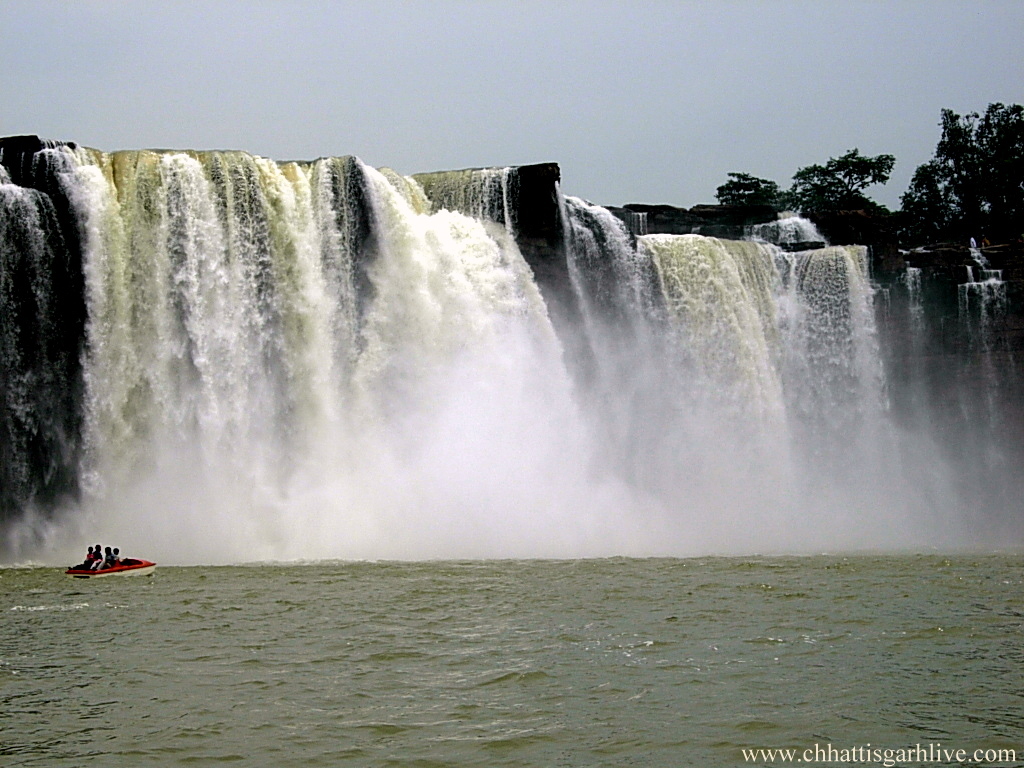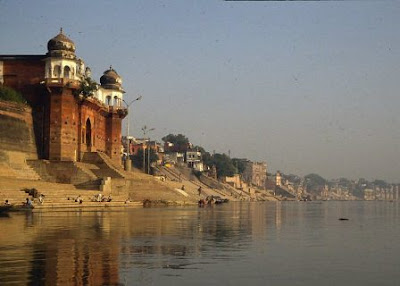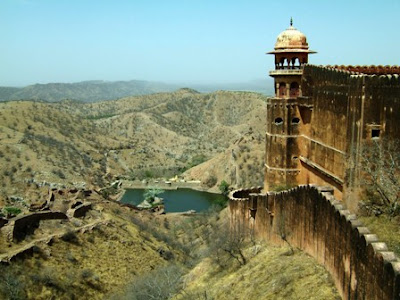
Sunday, December 11, 2011
Amarnath cave
The Amarnath cave shrine is situated on Mount Amarnath in the Indian state of Jammu & Kashmir. This important shrine situated about 48 km from pahalgam, located at an altitude of about 13000 feet, from sea level attracts devotees from all over India. This cave is one of the most famous shrines in Hinduism and dedicated to lord Shiva is believed to be his abode. The shrine is said to be over 5000 years old. The yatra starts from Pahalgam, offering the scenic beauty of Chandanwari, Sheshnaag and Panchtarni.
 Extending upto 130 feet, the cave is high and shallow. Inside a large opening, an underground trickle of water emerges 10 feet up from a small cleft in the sedimentary rock and freezes as it drips to from a tall, smooth cone of ice, which is believed to be a ‘Lingam’. The Lingam acquires a full from on Purnima as on that day, Lord Shiva is believed to have revealed the secrets of life to his consort Parvati. On this day of full moon, the pilgrims walk from Pahalgam to view the pure white lingam and they also make offerings of food, money, sweets and flowers.
Extending upto 130 feet, the cave is high and shallow. Inside a large opening, an underground trickle of water emerges 10 feet up from a small cleft in the sedimentary rock and freezes as it drips to from a tall, smooth cone of ice, which is believed to be a ‘Lingam’. The Lingam acquires a full from on Purnima as on that day, Lord Shiva is believed to have revealed the secrets of life to his consort Parvati. On this day of full moon, the pilgrims walk from Pahalgam to view the pure white lingam and they also make offerings of food, money, sweets and flowers.
Discovery of Holy Cave
The story narrated by people about the discovery of this Holy Cave is of a Gujjar (shepherd) Buta Malik. He is given the credit of discovering this Holy Cave. Story goes like this, that a saint gave Buta Malik a bag full of Coal. On reaching his home when he opened the bag, to his utter surprise the bag was full of gold coins. This made him overwhelmed with joy. He ran to thank the Saint. But, what he found was that the Saint had disappeared. Instead, he found The Holy Cave and Shiv Lingam there in. He announced the discovery of this to the Villagers. Then onwards this has become the sacred place of Pilgrimage.
The ancient epics narrate other story which goes like this. The valley of Kashmir was under water .It was a big lake. Kashyap Rishi drained the water through number of rivers and rivulets. In those days Bhrigu Rishi came that way on a visit to The Himalyas. He was the first to have Darshans of this Holy Cave. When people heard of the Lingam, Amarnath for them became Shiva’s abode and a Centre of pilgrimage. Since then Lacs of devotees perform the pilgrimage through tough terrain and avail eternal happiness.
The trek to Amarnath, in the month of sharavan (July–August) has the devout flock to this incredible shrine, where the image of Shiva, in the form of a Lingam, is formed naturally of an Ice Stalagmite, which waxes and wanes with the Moon's cycle. By its side are fascinating, two more Ice Lingams, that of Maa Parvati and of their son, Ganesha .
 How to reach Amarnath?
How to reach Amarnath?
By Air:
Amarnath does not have an airport, and the nearest airport is Srinagar, at a distance of 78 kms from Amarnath. Srinagar is summer capital of Jammu & Kashmir. There are daily flights to Srinagar from Delhi and Jammu.
By Rail:
Jammu is the nearest Railway Station. Jammu is winter Capital of Jammu & Kashmir. Jammu is a beautiful city and is also known as "City of Temples". It is well connected with all stations of India.
By Road:
Jammu and Srinagar are also connected through road. Buses and Taxies are also available for this part of the journey .These can be hired on daily as well as full tour basis.
 Cave Temple of Lord Amarnath
Cave Temple of Lord Amarnath
 Amarnath Wallpaper
Amarnath Wallpaper
 Amarnath Temple photo
Amarnath Temple photo

 Extending upto 130 feet, the cave is high and shallow. Inside a large opening, an underground trickle of water emerges 10 feet up from a small cleft in the sedimentary rock and freezes as it drips to from a tall, smooth cone of ice, which is believed to be a ‘Lingam’. The Lingam acquires a full from on Purnima as on that day, Lord Shiva is believed to have revealed the secrets of life to his consort Parvati. On this day of full moon, the pilgrims walk from Pahalgam to view the pure white lingam and they also make offerings of food, money, sweets and flowers.
Extending upto 130 feet, the cave is high and shallow. Inside a large opening, an underground trickle of water emerges 10 feet up from a small cleft in the sedimentary rock and freezes as it drips to from a tall, smooth cone of ice, which is believed to be a ‘Lingam’. The Lingam acquires a full from on Purnima as on that day, Lord Shiva is believed to have revealed the secrets of life to his consort Parvati. On this day of full moon, the pilgrims walk from Pahalgam to view the pure white lingam and they also make offerings of food, money, sweets and flowers.Discovery of Holy Cave
The story narrated by people about the discovery of this Holy Cave is of a Gujjar (shepherd) Buta Malik. He is given the credit of discovering this Holy Cave. Story goes like this, that a saint gave Buta Malik a bag full of Coal. On reaching his home when he opened the bag, to his utter surprise the bag was full of gold coins. This made him overwhelmed with joy. He ran to thank the Saint. But, what he found was that the Saint had disappeared. Instead, he found The Holy Cave and Shiv Lingam there in. He announced the discovery of this to the Villagers. Then onwards this has become the sacred place of Pilgrimage.
The ancient epics narrate other story which goes like this. The valley of Kashmir was under water .It was a big lake. Kashyap Rishi drained the water through number of rivers and rivulets. In those days Bhrigu Rishi came that way on a visit to The Himalyas. He was the first to have Darshans of this Holy Cave. When people heard of the Lingam, Amarnath for them became Shiva’s abode and a Centre of pilgrimage. Since then Lacs of devotees perform the pilgrimage through tough terrain and avail eternal happiness.
The trek to Amarnath, in the month of sharavan (July–August) has the devout flock to this incredible shrine, where the image of Shiva, in the form of a Lingam, is formed naturally of an Ice Stalagmite, which waxes and wanes with the Moon's cycle. By its side are fascinating, two more Ice Lingams, that of Maa Parvati and of their son, Ganesha .
 How to reach Amarnath?
How to reach Amarnath? By Air:
Amarnath does not have an airport, and the nearest airport is Srinagar, at a distance of 78 kms from Amarnath. Srinagar is summer capital of Jammu & Kashmir. There are daily flights to Srinagar from Delhi and Jammu.
By Rail:
Jammu is the nearest Railway Station. Jammu is winter Capital of Jammu & Kashmir. Jammu is a beautiful city and is also known as "City of Temples". It is well connected with all stations of India.
By Road:
Jammu and Srinagar are also connected through road. Buses and Taxies are also available for this part of the journey .These can be hired on daily as well as full tour basis.
 Cave Temple of Lord Amarnath
Cave Temple of Lord Amarnath Amarnath Wallpaper
Amarnath Wallpaper Amarnath Temple photo
Amarnath Temple photo
Amarnath cave
The Amarnath cave shrine is situated on Mount Amarnath in the Indian state of Jammu & Kashmir. This important shrine situated about 48 km from pahalgam, located at an altitude of about 13000 feet, from sea level attracts devotees from all over India. This cave is one of the most famous shrines in Hinduism and dedicated to lord Shiva is believed to be his abode. The shrine is said to be over 5000 years old. The yatra starts from Pahalgam, offering the scenic beauty of Chandanwari, Sheshnaag and Panchtarni.
 Extending upto 130 feet, the cave is high and shallow. Inside a large opening, an underground trickle of water emerges 10 feet up from a small cleft in the sedimentary rock and freezes as it drips to from a tall, smooth cone of ice, which is believed to be a ‘Lingam’. The Lingam acquires a full from on Purnima as on that day, Lord Shiva is believed to have revealed the secrets of life to his consort Parvati. On this day of full moon, the pilgrims walk from Pahalgam to view the pure white lingam and they also make offerings of food, money, sweets and flowers.
Extending upto 130 feet, the cave is high and shallow. Inside a large opening, an underground trickle of water emerges 10 feet up from a small cleft in the sedimentary rock and freezes as it drips to from a tall, smooth cone of ice, which is believed to be a ‘Lingam’. The Lingam acquires a full from on Purnima as on that day, Lord Shiva is believed to have revealed the secrets of life to his consort Parvati. On this day of full moon, the pilgrims walk from Pahalgam to view the pure white lingam and they also make offerings of food, money, sweets and flowers.
Discovery of Holy Cave
The story narrated by people about the discovery of this Holy Cave is of a Gujjar (shepherd) Buta Malik. He is given the credit of discovering this Holy Cave. Story goes like this, that a saint gave Buta Malik a bag full of Coal. On reaching his home when he opened the bag, to his utter surprise the bag was full of gold coins. This made him overwhelmed with joy. He ran to thank the Saint. But, what he found was that the Saint had disappeared. Instead, he found The Holy Cave and Shiv Lingam there in. He announced the discovery of this to the Villagers. Then onwards this has become the sacred place of Pilgrimage.
The ancient epics narrate other story which goes like this. The valley of Kashmir was under water .It was a big lake. Kashyap Rishi drained the water through number of rivers and rivulets. In those days Bhrigu Rishi came that way on a visit to The Himalyas. He was the first to have Darshans of this Holy Cave. When people heard of the Lingam, Amarnath for them became Shiva’s abode and a Centre of pilgrimage. Since then Lacs of devotees perform the pilgrimage through tough terrain and avail eternal happiness.
The trek to Amarnath, in the month of sharavan (July–August) has the devout flock to this incredible shrine, where the image of Shiva, in the form of a Lingam, is formed naturally of an Ice Stalagmite, which waxes and wanes with the Moon's cycle. By its side are fascinating, two more Ice Lingams, that of Maa Parvati and of their son, Ganesha .
 How to reach Amarnath?
How to reach Amarnath?
By Air:
Amarnath does not have an airport, and the nearest airport is Srinagar, at a distance of 78 kms from Amarnath. Srinagar is summer capital of Jammu & Kashmir. There are daily flights to Srinagar from Delhi and Jammu.
By Rail:
Jammu is the nearest Railway Station. Jammu is winter Capital of Jammu & Kashmir. Jammu is a beautiful city and is also known as "City of Temples". It is well connected with all stations of India.
By Road:
Jammu and Srinagar are also connected through road. Buses and Taxies are also available for this part of the journey .These can be hired on daily as well as full tour basis.
 Cave Temple of Lord Amarnath
Cave Temple of Lord Amarnath
 Amarnath Wallpaper
Amarnath Wallpaper
 Amarnath Temple photo
Amarnath Temple photo

 Extending upto 130 feet, the cave is high and shallow. Inside a large opening, an underground trickle of water emerges 10 feet up from a small cleft in the sedimentary rock and freezes as it drips to from a tall, smooth cone of ice, which is believed to be a ‘Lingam’. The Lingam acquires a full from on Purnima as on that day, Lord Shiva is believed to have revealed the secrets of life to his consort Parvati. On this day of full moon, the pilgrims walk from Pahalgam to view the pure white lingam and they also make offerings of food, money, sweets and flowers.
Extending upto 130 feet, the cave is high and shallow. Inside a large opening, an underground trickle of water emerges 10 feet up from a small cleft in the sedimentary rock and freezes as it drips to from a tall, smooth cone of ice, which is believed to be a ‘Lingam’. The Lingam acquires a full from on Purnima as on that day, Lord Shiva is believed to have revealed the secrets of life to his consort Parvati. On this day of full moon, the pilgrims walk from Pahalgam to view the pure white lingam and they also make offerings of food, money, sweets and flowers.Discovery of Holy Cave
The story narrated by people about the discovery of this Holy Cave is of a Gujjar (shepherd) Buta Malik. He is given the credit of discovering this Holy Cave. Story goes like this, that a saint gave Buta Malik a bag full of Coal. On reaching his home when he opened the bag, to his utter surprise the bag was full of gold coins. This made him overwhelmed with joy. He ran to thank the Saint. But, what he found was that the Saint had disappeared. Instead, he found The Holy Cave and Shiv Lingam there in. He announced the discovery of this to the Villagers. Then onwards this has become the sacred place of Pilgrimage.
The ancient epics narrate other story which goes like this. The valley of Kashmir was under water .It was a big lake. Kashyap Rishi drained the water through number of rivers and rivulets. In those days Bhrigu Rishi came that way on a visit to The Himalyas. He was the first to have Darshans of this Holy Cave. When people heard of the Lingam, Amarnath for them became Shiva’s abode and a Centre of pilgrimage. Since then Lacs of devotees perform the pilgrimage through tough terrain and avail eternal happiness.
The trek to Amarnath, in the month of sharavan (July–August) has the devout flock to this incredible shrine, where the image of Shiva, in the form of a Lingam, is formed naturally of an Ice Stalagmite, which waxes and wanes with the Moon's cycle. By its side are fascinating, two more Ice Lingams, that of Maa Parvati and of their son, Ganesha .
 How to reach Amarnath?
How to reach Amarnath? By Air:
Amarnath does not have an airport, and the nearest airport is Srinagar, at a distance of 78 kms from Amarnath. Srinagar is summer capital of Jammu & Kashmir. There are daily flights to Srinagar from Delhi and Jammu.
By Rail:
Jammu is the nearest Railway Station. Jammu is winter Capital of Jammu & Kashmir. Jammu is a beautiful city and is also known as "City of Temples". It is well connected with all stations of India.
By Road:
Jammu and Srinagar are also connected through road. Buses and Taxies are also available for this part of the journey .These can be hired on daily as well as full tour basis.
 Cave Temple of Lord Amarnath
Cave Temple of Lord Amarnath Amarnath Wallpaper
Amarnath Wallpaper Amarnath Temple photo
Amarnath Temple photo
Subscribe to:
Comments (Atom)




































